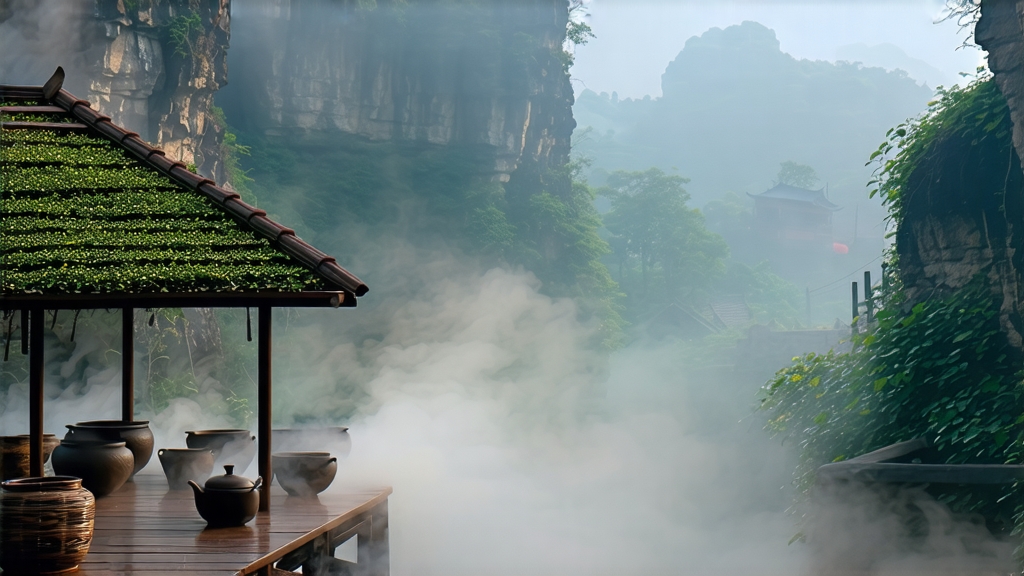
Among the six major families of Chinese tea, oolong alone occupies the aromatic midpoint between green freshness and black depth. Within that spectrum, no cultivar carries more myth, prestige, and sensory drama than Da Hong Pao—literally “Big Red Robe”—grown on the vertiginous basalt cliffs of Wuyishan, Fujian Province. To the Chinese palate it is the embodiment of yan yun, the “rock rhyme” said to echo in the throat after each sip like the lingering note of a guqin string. To the global tea traveler it is a pilgrimage: narrow plank walkways bolted into sheer rock, mist drifting across a gorge that once sheltered Ming-dynasty monks, and the faint scent of charcoal drifting from tiny factories that still roast tea the way their grandfathers did.
Origin stories date to the early 15th century. The most quoted tells of a Ming scholar who, while en route to the capital for imperial exams, fell gravely ill near Wuyi’s Nine-Dragon Gorge. Monks from the nearby Tianxin Temple brewed leaves picked from four stunted bushes clinging to the cliff; the traveler recovered, passed the exams, and returned in gratitude with a crimson imperial robe. He draped the robe over the bushes, declaring them “red-robed tea ancestors.” Whether legend or marketing genius, the name stuck, and those four mother trees—still visible but no longer harvested—became a living monument protected by armed guards and insured for over one million US dollars.
Botanically, Da Hong Pao is a collective brand rather than a single plant. The original “Qi Dan” cuttings were grafted and distributed across the Wuyi micro-region, producing a constellation of cultivars—Bei Dou, Que She, Tieluohan, Baijiguan—each adapting to its own ravine of mineral soil and diffused light. Today the label “Da Hong Pao” can denote three tiers: (1) “Mother Tree” tea, last harvested in 2006 for state gifts; (2) “Purebred” tea from genetically verified Qi Dan cuttings; and (3) the market-dominant “blended” version, where yan yun teas such as Rou Gui and Shui Xian are skillfully married to approximate the depth of the original. Discerning drinkers prize the second category, yet a well-executed blend can still deliver the limestone minerality and cooling camphor finish that define the style.
Crafting Da Hong Pao is a two-week choreography of stress and rest. Picking occurs only in late April, when three half-open leaves atop a tender bud guarantee the highest aromatic oils. The pluck is spread on bamboo trays to wither under the mountain breeze and intermittent sun, initiating enzymatic oxidation. Once the leaf edges turn chestnut brown, tumbling in a heated bamboo drum arrests oxidation at roughly 40 %—the oolong sweet spot. What follows is Wuyi’s signature charcoal roasting: bundles of tea are loaded into rattan baskets lowered into the mouth of a subdued charcoal pit fired by local hardwood. The roaster’s bare hand inserts a metal trowel between baskets every twenty minutes, judging temperature by the sting on his palm. Over 6–12 hours the leaves lose another 15 % moisture, folding into the characteristic dark, ribbon-like twists that smell of toasted cacao and dried plum. After a fortnight of resting in earthen jars the tea is roasted again, lighter this time, to fix the bouquet. A third, even gentler bake may follow months later, embedding layers of aroma that will unfurl gradually in the cup.
Water is the silent ingredient. At the cliff gardens the annual rainfall exceeds 2,000 mm, but the porous volcanic rock drains instantly, forcing roots to dive three meters for groundwater rich in potassium and micro-elements. This hydric stress concentrates polyphenols and aromatic precursors, yielding the unmistakable “rock bone” texture—an astringency that feels like licking wet slate, then dissolves into nectar.
To brew Da Hong Pao gongfu style, begin with a 100 ml porcelain gaiwan or petite Yixing teapot previously dedicated to yan cha (rock tea). Use 5 g of leaf—about one heaping tablespoon—for every 100 ml. Bring freshly drawn spring water to a rolling boil, then pre-heat every vessel so that the first encounter with leaf is never lukewarm. Rinse